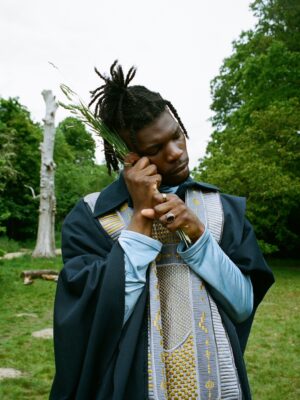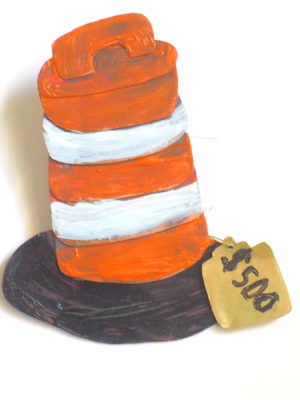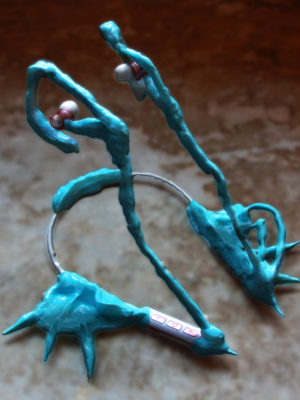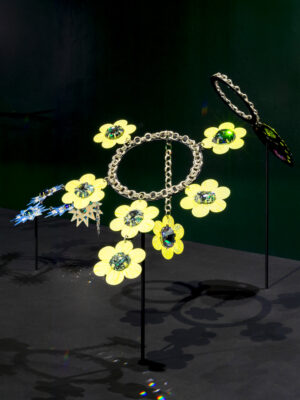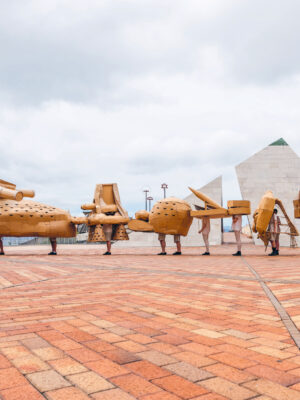VG: Your illustrations have such powerful characteristics, they seem to constitute an essential source of expression in your process. Can you tell us more about the role of your drawings in your work?
VG: Do your drawings represent the intended audience for your work or a way of visualising that audience?
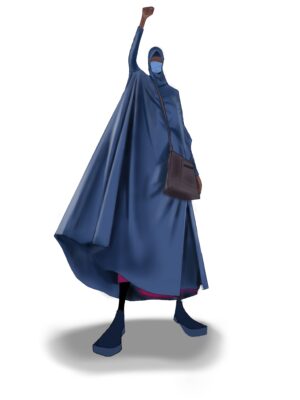
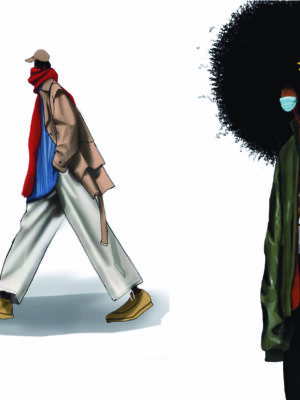
VG: I read about the dye technique you used to achieve the unique blue tones we can see throughout your collection. Can you tell us more about the method you used?
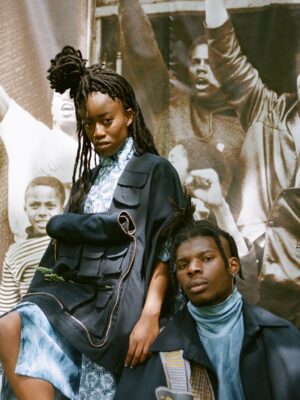
VG: Your clothes are gender fluid, and your themes are often based on political and social awareness. Does this reflect your approach to fashion?
JJ: It was mainly for this collection because it was about empowering people during the End SARS movement, which was the protest against police brutality in Nigeria in 2020. During this research, I looked at our traditional clothing and traditional techniques, So it was very specific to that collection. But I generally like monochromatic colour when it comes to my design.
VG: Can we talk about the theme you chose for your graduation collection? What was the reception to this work among your fellow students, teachers and the greater audience?
JJ: That’s a very good question because when I started doing it, I was convinced that I was not going to be understood, because it was so specifically about what was going on in my country. And even the research and the development were very niche to our traditional clothing. So when I started developing the shapes and things, people began responding gradually to them in a positive way, I was quite surprised. But even more surprised that when I finished the collection and presented it, I won the Black Excellence Award. I got a lot of great responses from it that blew my mind because I didn’t think- I started thinking, you know what? I don’t care. I’m just going to do this because I was talking about something that really mattered to me, which is to be understood. And I felt empowered that I could literally do whatever, and as long as it matters, the right people will get it.
VG: The emotion of empowerment strongly comes through your work. Is this the feeling that you primarily want to express within your design?
JJ: Absolutely. I think the essence of design for me, is empowerment, is how to make people feel different when they wear the clothes. It’s like a second skin like you wear something I created, and that makes you feel like you’re invincible, that makes you feel like you’re protected. So everything from utility wear to blazers is about empowering.
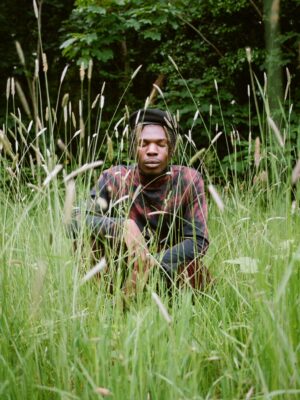
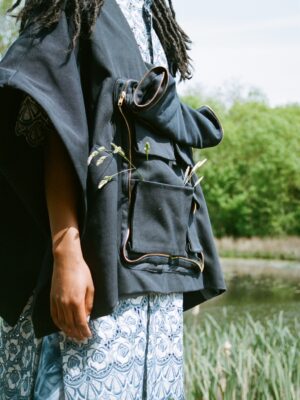
VG: I had read in an article that for you, winning the prize of FACE meant that you had been seen and heard.
Can you tell us more about how winning this prize affected you?
What did it change?
JJ: Yes, absolutely. Because coming out of Uni, especially for the person of colour, you don’t have a lot of examples, and you’re like, okay, what to do next? Especially when you are starting from zero. But with this prize and the type of recognition and the exposure, it gave me the confidence to say, you know what, I will be ok. I’ve been in various magazines, I’ve had people contact me privately, people who wanted my advice. And I think it put me in the right position; helped me kickstart my career and gave me the confidence to find my way in the fashion industry.
VG: But it also sounds like it allowed you to do fashion differently – maybe move into some areas that can be explored to redefine some of fashion’s traditional blind spots. How do you see that?
JJ: It gave me, as you said, the freedom to think about the blind spots and the possibility to do fashion my way. So, I’ve been taking time to reflect on the things that matter. Because my collection did matter, and it created conversations.
I’m trying to figure out what is right for me, and I have the space to do it. I look at those blind spots in the fashion industry, as a person of colour, as a queer person of colour, and as an African. Because even though I grew up in Europe, I’m still African. So there are lots of things I would like to explore. But I think what’s important is for me to narrow it down to something that I really feel is empowering and is going to make a difference in people’s lives.
VG: Your clothes are gender fluid, and your themes are often based on political and social awareness. Does this reflect your approach to fashion?
JJ: So I’ve realised I’ve always wanted to do menswear because women could also wear it. I wanted to make neutral clothing so that both genders could wear it because I wear men’s clothing all the time. But I’ve gotten to a point where I figured out that that’s not the solution because men’s clothing doesn’t always sit right on a woman, and the fit is not always flattering for an androgynous, nonbinary person either. And with those reflections, I have the space to think-I think that was a mistake I’d made in the past, and I want to rectify it with time, but it’s still all in the works.
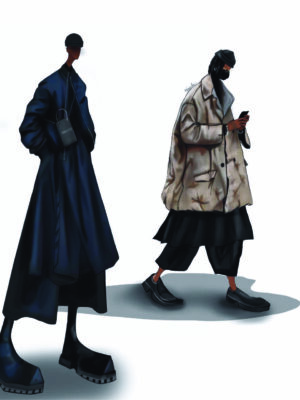
GV: What is it about fashion design specifically that allows you to express your personal cultural identity? Could you talk about that?
JJ: I feel like I’m very multicultural; when I was growing up in Nigeria, I went to a British school. We wore British uniforms, and my dad would wear suits, but at the same time wearing traditional attires. So I think as a small girl, I could see myself as someone with a mixed cultural background already. Then I moved to Switzerland, which is a different culture from those two because there’s nothing British in Switzerland. So I developed a new culture and a new way of being. Moving to London as an adult, I remembered the culture I had in Nigeria when I was young. And I think that’s what’s been really interesting to me. It’s like expressing those cultures is my life journey. When it comes to design, we can talk about menswear; for example, I see a lot of influence from my uncles, but my uncles were in Nigeria. And in the 1990s, they wore large T-shirts and Timberlands, and on Sundays, they would wear pants, shirts with agbada. And that’s the culture I am talking about. That definitely is the way I see it. I’m not just one culture; I’m all the cultures, and I can express that through design which is what I’m really excited about. One of the ways I expressed that through my graduate collection was by using military details. Also, the tie-dye from my culture and drapes allow me to express my multicultural self from this different angle.
VG: What are you working on right now?
JJ: I am a designer for a startup at the moment. The piece I’m making for the Christopher Kane zine (PLATFORM) is also giving the space to explore and create. I’m passionate about many different things, so it is essential to have all these experiences to help me find the right direction. I’m figuring everything out as I go.
